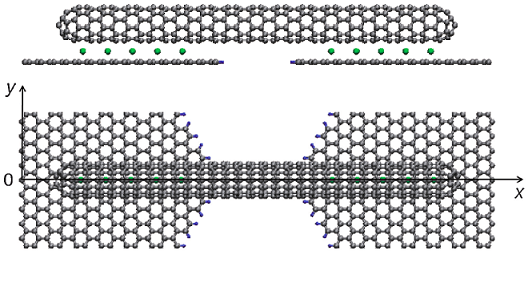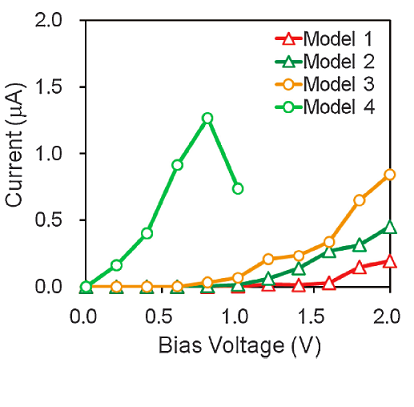

Research Highlights:
Contact governs electronic transport of carbon nanotubes
 Figure: Finite-length carbon nanotubes bridged between
Figure: Finite-length carbon nanotubes bridged between
graphen electrodes, corresponding to Model 4.
An ultimate goal for minutualization of electronic devices is to control device structures
in atomic level so that the devices can possess desired electronic transport properties.
In this sense, carbon-based materials form a wide variety of geometrical structures which
may provide a platform enabling us structural fine tunning.
Among those carbon-based materials, carbon nanotubes (CNT) are known to be an ideal conductor
that electrons can ballistically transfer without being scattered for long distance path.
To address feasiblity of such a device based on CNT, we have performed large-scale electronic
transport calculations of finite-length zigzag carbon nanotubes with caps bridged between
graphene electrodes, based on the density functional theory (DFT) and nonequilibrium Green's
function (NEGF) method.
 Figure: Current as a function of bias voltage
Figure: Current as a function of bias voltage
The electronic transport properties vary with the length of the nanotubes
and the contact structure. Despite the use of thin nanotubes expected to show n-type behavior,
the Fermi level of the shorter nanotubes is uniformly pinned to the cap state, forming a large
conduction gap. Although the longer nanotubes still have a medium conduction gap after forming
a Schottky-like contact, the lithium intercalation in the contact area brings about a good ohmic
property due to not only doping but also the orbital hybridization, which strongly suggests
the importance of controlling contact structure between CNT and electrodes.
The research was conducted in collaboration with Fujitsu Laboratories.
-
"Large-Scale Electronic Transport Calculations of Finite-Length Carbon Nanotubes Bridged between
Graphene Electrodes with Lithium-Intercalated Contact",
M. Ohfuchi, T. Ozaki, and C. Kaneta, Appl. Phys. Express 4, 095101 (2011).



